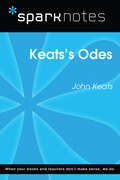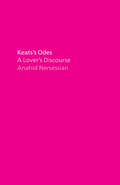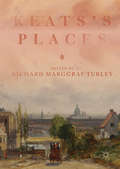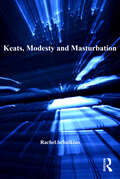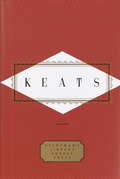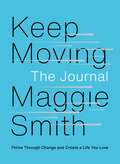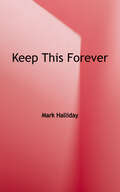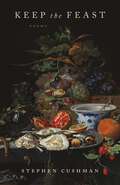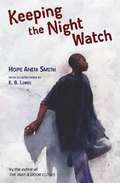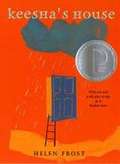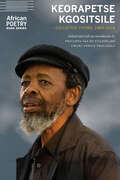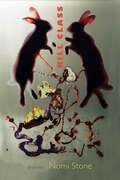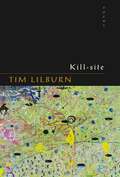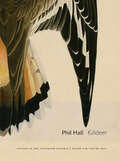- Table View
- List View
Keats's Odes (SparkNotes Literature Guide Series)
by SparkNotesKeats's Odes (SparkNotes Literature Guide) by John Keats Making the reading experience fun! Created by Harvard students for students everywhere, SparkNotes is a new breed of study guide: smarter, better, faster. Geared to what today's students need to know, SparkNotes provides: *Chapter-by-chapter analysis *Explanations of key themes, motifs, and symbols *A review quiz and essay topicsLively and accessible, these guides are perfect for late-night studying and writing papers
Keats's Odes: A Lover's Discourse
by Anahid Nersessian“When I say this book is a love story, I mean it is about things that cannot be gotten over—like this world, and some of the people in it.” In 1819, the poet John Keats wrote six poems that would become known as the Great Odes. Some of them—“Ode to a Nightingale,” “To Autumn”—are among the most celebrated poems in the English language. Anahid Nersessian here collects and elucidates each of the odes and offers a meditative, personal essay in response to each, revealing why these poems still have so much to say to us, especially in a time of ongoing political crisis. Her Keats is an unflinching antagonist of modern life—of capitalism, of the British Empire, of the destruction of the planet—as well as a passionate idealist for whom every poem is a love poem. The book emerges from Nersessian’s lifelong attachment to Keats’s poetry; but more, it “is a love story: between me and Keats, and not just Keats.” Drawing on experiences from her own life, Nersessian celebrates Keats even as she grieves him and counts her own losses—and Nersessian, like Keats, has a passionate awareness of the reality of human suffering, but also a willingness to explore the possibility that the world, at least, could still be saved. Intimate and speculative, this brilliant mix of the poetic and the personal will find its home among the numerous fans of Keats’s enduring work.
Keats's Places
by Richard Marggraf TurleyAs the essays in this volume reveal, Keats’s places could be comforting, familiar, grounding sites, but they were also shifting, uncanny, paradoxical spaces where the geographical comes into tension with the familial, the touristic with the medical, the metropolitan with the archipelagic. Collectively, the chapters in Keats’s Places range from the claustrophobic stands of Guy’s Hospital operating theatre to the boneshaking interior of the Southampton mail coach; from Highland crags to Hampstead Heath; from crowded city interiors to leafy suburban lanes. Offering new insights into the complex registrations of place and the poetic imagination, the contributors to this book explore how the significant places in John Keats’s life helped to shape an authorial identity.
Keats, Modesty and Masturbation
by Rachel SchulkinsExamining John Keats’s reworking of the romance genre, Rachel Schulkins argues that he is responding to and critiquing the ideals of feminine modesty and asexual femininity advocated in the early nineteenth century. Through close readings of Isabella; or the Pot of Basil, The Eve of St. Agnes, Lamia and ’La Belle Dame sans Merci,’ Schulkins offers a re-evaluation of Keats and his poetry designed to demonstrate that Keats’s sexual imagery counters conservative morality by encoding taboo desires and the pleasures of masturbation. In so doing, Keats presents a version of female sexuality that undermines the conventional notion of the asexual female. Schulkins engages with feminist criticism that largely views Keats as a misogynist poet who is threatened by the female’s overwhelming sexual and creative presence. Such criticism, Schulkins shows, tends towards a problematic identification between poet and protagonist, with the text seen as a direct rendering of authorial ideology. Such an interpretation neither distinguishes between author, protagonist, text, social norms and cultural history nor recognises the socio-sexual and political undertones embedded in Keats’s rendering of the female. Ultimately, Schulkins’s book reveals how Keats’s sexual politics and his refutation of the asexual female model fed the design, plot and vocabulary of his romances.
Keats: A Brief Life in Nine Poems and One Epitaph
by Lucasta MillerA dazzling new look into the short but intense, tragic life and remarkable work of John Keats, one of the greatest lyric poets of the English language, seen in a whole new light, not as the mythologized Victorian guileless nature-lover, but as the subversive, bawdy complex cynic whose life and poetry were lived and created on the edge.In this brief life, acclaimed biographer Lucasta Miller takes nine of Keats's best-known poems—"Endymion"; "On First Looking into Chapman&’s Homer"; "Ode to a Nightingale"; "To Autumn"; "Bright Star" among them—and excavates how they came to be and what in Keats's life led to their creation. She writes of aspects of Keats's life that have been overlooked, and explores his imagination in the context of his world and experience, paying tribute to the unique quality of his mind. Miller, through Keats&’s poetry, brilliantly resurrects and brings vividly to life, the man, the poet in all his complexity and spirit, living dangerously, disdaining respectability and cultural norms, and embracing subversive politics. Keats was a lower-middle-class outsider from a tragic and fractured family, whose extraordinary energy and love of language allowed him to pummel his way into the heart of English literature; a freethinker and a liberal at a time of repression, who delighted in the sensation of the moment. We see how Keats was regarded by his contemporaries (his writing was seen as smutty) and how the young poet&’s large and boisterous life—a man of the metropolis, who took drugs, was sexually reckless and afflicted with syphilis—went straight up against the Victorian moral grain; and Miller makes clear why his writing—considered marginal and avant-garde in his own day—retains its astonishing originality, sensuousness and power two centuries on.
Keats: Poems
by John KeatsThese Everyman's Library Pocket Poets hardcover editions are popular for their compact size and reasonable price which do not compromise content. Poems: Keats contains a full selection of Keats's work, including his lyric poems, narrative poems, letters, and an index of first lines.
Keats’s Reading / Reading Keats: Essays in Memory of Jack Stillinger
by Daniel Johnson Beth Lau Greg KucichThis book explores John Keats’s reading practices and intertextual dialogues with other writers. It also examines later writers’ engagements with Keats’s poetry. Finally, the book honors the distinguished Keats scholar Jack Stillinger and includes an essay surveying his career as well as a bibliography of his major publications. The first section of the volume, “Theorizing Keats’s Reading,” contains four essays that identify major patterns in the poet’s reading habits and responses to other works. The next section, “Keats’s Reading,” consists of six essays that examine Keats’s work in relation to specific earlier authors and texts. The four essays in the third section, “Reading Keats,” consider how Keats’s poetry influenced the work of later writers and became embedded in British and American literary traditions. The final section of the book, “Contemporary Poetic Responses,” features three scholar-poets who, in poetry and/or prose commentary, discuss and exemplify Keats’s impact on their work.
Keep Moving: Thrive Through Change and Create a Life You Love
by Maggie SmithBased on the national bestseller Keep Moving—called &“a meditation on kindness and hope&” (NPR)—a 52-exercise journal about hope and renewal from the award-winning poet and author of You Could Make This Place Beautiful. As Maggie Smith navigated loss and upheaval, she wrote to herself each day—forgiving herself for a past mistake, reflecting on moments of joy, or looking towards the future, ending each note-to-self with the phrase &“keep moving.&” In her own words, &“I wasn&’t offering wisdom from on high; I was talking to myself at the bottom of a dark well, trying to climb up into the light, little by little, day by day.&” Smith was surprised not only by how uplifting this process was, but also by the outpouring of support and gratitude from thousands of people who found solace in her words. Through the healing power of writing, Keep Moving: The Journal invites us to find beauty in the present moment, embrace change, and create a life we love.
Keep This Forever
by Mark HallidayIn this book, the author proves to be one of America's most intimate poets. Like Frank O'Hara and Kenneth Koch, his poems chat with the reader in earnest yet humorous ways and in wholly believable voices. Whether exploring grief or desire or loneliness, these poems never forget the human longing for permanence. "He is prolix and quotidian, a Whitman in a supermarket, a confessional poet who does not take himself very seriously.... His cool patter skewers pomposity..."--The New Yorker.
Keep on Singing: A Ballad of Marian Anderson
by Myra Cohn Livingston"When she sang Deep River, One teacher wondered why A tall, calm girl at twilight Should make him want to cry." (The teacher was Arturo Toscanini.) Other books by this American poet are available in this library.
Keep the Feast: Poems
by Stephen CushmanStephen Cushman’s Keep the Feast sings in the tradition of the psalmists and devotional poets, offering an intimate, ecstatic doxology, both exultant and indicting, spiritual and secular. His poems make prodigious and intrepid forays into the realms of history, sexuality, religious ardor, the imperiled planet, and the reasons for making art. At the heart of this three-part book lies the title poem, which takes as a formal model Psalm 119, the longest psalm in the Bible. In luminous verse, Cushman’s speaker rejoices in the commitments of faith, finding in them a way of living with the paradoxes of twenty-first-century life and of holding belief in an often-unfathomable world.
Keeping the Night Watch
by Hope Anita SmithSo many unanswered questions weigh down thirteen-year-old C.J. As he struggles to understand why his father walked out. His father is back now, though C.J. Is not as quick to forgive as the other members of his family. He still feels the weight of responsibility that fell on his shoulders when Daddy was gone, and he's not prepared to give that up. But C.J.'S anger is making him a stranger in his own home, and instead of life seeming better now that Daddy has returned, it feels worse. Through powerful poems, Hope Anita Smith chronicles the nuanced emotions of a family that is slowly learning to heal and put the pieces back together.
Keesha's House
by Helen FrostAn unforgettable narrative collage told in poems Keesha has found a safe place to live, and other kids gravitate to her house when they just can’t make it on their own. They are Stephie – pregnant, trying to make the right decisions for herself and those she cares about; Jason – Stephie’s boyfriend, torn between his responsibility to Stephie and the baby and the promise of a college basketball career; Dontay – in foster care while his parents are in prison, feeling unwanted both inside and outside the system; Carmen – arrested on a DUI charge, waiting in a juvenile detention center for a judge to hear her case; Harris – disowned by his father after disclosing that he’s gay, living in his car, and taking care of himself; Katie – angry at her mother’s loyalty to an abusive stepfather, losing herself in long hours of work and school. Stretching the boundaries of traditional poetic forms – sestinas and sonnets – Helen Frost’s extraordinary debut novel for young adults weaves together the stories of these seven teenagers as they courageously struggle to hold their lives together and overcome their difficulties.
Keorapetse Kgositsile: Collected Poems, 1969–2018 (African Poetry Book)
by Keorapetse KgositsileKeorapetse Kgositsile, South Africa&’s second poet laureate, was a political activist, teacher, and poet. He lived, wrote, and taught in the United States for a significant part of his life and collaborated with many influential and highly regarded writers, including Gwendolyn Brooks, Sterling Plumpp, Dudley Randall, and George Kent. This comprehensive collection of Kgositsile&’s new and collected works spans almost fifty years. During his lifetime, Kgositsile dedicated the majority of his poems to people or movements, documenting the struggle against racism, Western imperialism, and racial capitalism, and celebrating human creativity, particularly music, as an inherent and essential aspect of the global liberation struggle. This collection demonstrates the commitment to equality, justice, and egalitarianism fostered by cultural workers within the mass liberation movement. As the introduction notes, Kgositsile had an &“undisputed ability to honor the truth in all its complexity, with a musicality that draws on the repository of memory and history, rebuilt through the rhythms and cadences of jazz.&” Addressing themes of Black solidarity, displacement, and anticolonialism, Kgositsile&’s prose is fiery, witty, and filled with conviction. This collection showcases a voice that wanted to change the world—and did.
Keystone Poetry: Contemporary Poets on Pennsylvania (Keystone Books)
by Marjorie Maddox Jerry WempleFrom Philadelphia to Erie, and from the shale fields to the coal mines, Keystone Poetry celebrates the varied landscapes and voices of Pennsylvania. This collection brings together the work of 182 poets who, with keen eyes and powerful language, commemorate the hometowns, history, traditions, and culture of the Commonwealth.Organized geographically, the poems traverse county lines, ancestral lineages, and thematic concerns—as well as gender, racial, and socioeconomic barriers. The poems in this collection seek to bring the reader close to home while fostering the discovery of new places and a deeper understanding of all those who live in the Keystone State.Keystone Poetry also includes resources for teachers. Drawing from this collection of place-based literature, high school and college educators can use students’ hometown experiences to make disciplines such as literature, composition, creative writing, history, geography, sociology, political science, and psychology more engaging and accessible. • To delve more deeply into class discussion, see “Let’s Talk About It,” a helpful aid for individual or group reflection.• To fuel creativity, access “Let’s Write About It,” a practical guide to inspire writers of all levels.
Khasi Folk Songs and Tales
by Desmond L. Kharmawphlang A.R. TripathiThe dialects and languages spoken by tribals in India are very large in number. The literary compositions in most of them have survived in oral form, though some tribal languages have taken to writing as a means of recording literary compositions. Documented and translated into English by Desmond L. Kharmawphlang. Translated into Hindi by A. R. Tripathi.
Kicks: Sneaker Microfiction And Poetry
by Van G. Garrett“A brilliantly written and illustrated ode to sneakers and sneakerheads, young and old. A gift to us all.” —Angie Thomas, #1 New York Times bestselling authorA fun, lyrical debut picture book, Kicks is an essential read for sneaker fans of all ages, from award-winning poet Van G. Garrett and New York Times bestselling illustrator Reggie Brown.This is a love letter to sneakers. But not just any sneakers. Only the flyest, floatiest, you-est kicks you can get—the ones that let you soar!This colorful, rhythmic adventure has something to offer anyone who prizes a great pair of shoes and any reader who loves to play with words.
Kids Pick The Funniest Poems: Poems That Make Kids Laugh (Giggle Poetry)
by Bruce Lansky Stephen CarpenterBetcha laugh!This is one of the most popular collections of funny poetry for kids ever published. It's a classic because it's the first collection of poems selected by kids! It includes clever creations from some of the most popular names in children's poetry, including Bill Dodds, Timothy Tocher, Joyce Armor, Robert Pottle, Bruce Lansky, and Kenn Nesbitt. Humorous illustrations by Stephen Carpenter make this book even better.
Kill Class: Poems
by Nomi StoneA poet and anthropologist explores the surprising world of war games in mock Middle Eastern villages in which the U.S. military trains. With deft lyrical attention, these documentary poems reveal the nuanced culture and violence of the war machine--alive and well within these basecamp villages, the American military, and, ultimately, the human heart. Kill Class is based on Nomi Stone's two years of fieldwork in mock Middle Eastern villages at military bases across the United States. The speaker in these poems, an anthropologist, both witnesses and participates in combat training exercises staged at Pineland, a simulated country in the woods of the American South, where actors of Middle Eastern origin are hired to theatricalize war, repetitively pretending to bargain and mourn and die. Kill Class is an arresting ethnography of American military culture, one that allows readers to circle at length through the cloverleaf interchanges where warfare nestles into even the most mundane corners of everyday life.
Kill or Cure
by Anne Waldman"Kill Or Cure," a bold prescriptive for these apocalyptic days, brings together substantial new work as well as the best of Anne Waldman's previously uncollected poetry. It includes credos, manifestos, dreams, homages to literary predecessors, "Shaman Hisses You Slide Back Into The Night" (the journal poem written during Bob Dylan's historic Rolling Thunder Revue), witty political diatribes, travel vignettes, incantations, and a new section of the ongoing epic poem "Iovis," a powerful meditation on male energy.
Kill-site
by Tim LilburnBy the winner of the Saskatchewan Book Award for Best Book of the YearTo his virtuoso collection of new poems, Tim Lilburn brings a philosopher’s mind and the eyes and ears of a marsh hawk. This series of earthy meditations makes the strange familiar and the familiar strange. Lilburn’s close study of goldenrod, an ice sheet, or night opens into surprising interior and subterranean worlds. Pythagoras lurks within the poplars, Socrates in stones, people fly below the ground. Elsewhere, the human presence of motels and beer parlours is ominous. Kill-site is an exploration of a human’s animal nature. Lilburn invites the reader to: “Go below the small things… then / walk inside them and you have their kindness.” Though a natural progression from Lilburn’s last book, To the River, in Kill-site, the poet moves toward a greater understanding of the human, of sacrifice.
Killarnoe
by Sonnet L'AbbeWith its razzle-dazzle wordplay and kaleidoscope of subjects, Sonnet L’Abbé’s second collection of poems is a tour-de-force. L’Abbé invents her own unique poetics, coupling a glittering variety of patterns with tumbling rhythms and rhymes. And with this refreshed language, she reconsiders all the rules for twenty-first-century life. The poems work like a whirlwind, ranging from the intimacy of infancy to the shock of whole civilizations razed by war, and are infused with a political undertone that reveals a child’s emerging understanding of identity, of specific citizenship, of bodies physical and psychological, of language, imagination, and dream. Whether funny or funky, candid or subtle, amused and ironic or stunned in fright, the poems are guided by a fierce intelligence that never oversimplifies the world. Killarnoe, the poet tells us, “is a place I invented right now. I just built it from my head.” And in its reconsideration of what it means to be, Killarnoe is fascinating, charged, and inspired.
Killdeer: essay-poems (Department of Critical Thought #4)
by Phil HallWINNER OF THE 75th GOVERNOR GENERAL'S LITERARY AWARD FOR POETRYWINNER OF THE 25th TRILLIUM BOOK PRIZEWINNER OF AN ALCUIN AWARD FOR DESIGNSHORTLISTED FOR THE GRIFFIN POETRY PRIZEThese are poems of critical thought that have been influenced by old fiddle tunes. These are essays that are not out to persuade so much as ruminate, invite, accrue.Hall is a surruralist (rural & surreal), and a terroir-ist (township-specific regionalist). He offers memories of, and homages to -- Margaret Laurence, Bronwen Wallace, Libby Scheier, and Daniel Jones, among others. He writes of the embarrassing process of becoming a poet, and of his push-pull relationship with the whole concept of home. His notorious 2004 chapbook essay The Bad Sequence is also included here, for a wider readership, at last. It has been revised. (It's teeth have been sharpened.)In this book, the line is the unit of composition; the reading is wide; the perspective personal: each take a give, and logic a drawback.Language is not a smart-aleck; it's a sacred tinkerer.Readers are invited to watch awe become a we.In Fred Wah's phrase, what is offered here is "the music at the heart of thinking."
